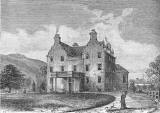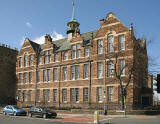|
Peffermill and Prestonfield |
|
Recollections |
||
|
1 |
George T Smith |
- Schools |
|
2 |
Bryan Gourlay |
- Peffermill - Kirkhill - School - The Divide |
|
3 |
Bryan Gourlay |
- Pulleys - Wash Day - Drying the Clothes - A Change of Clothes - Guiders - On the Road |
|
4 |
Bryan Gourlay |
- Peffermill Tin School - Haloween - Gas Pokers |
|
5 |
- Guiders |
|
1. Recollections from George T Smith British Columbia, Canada |
|
Thank you to George T Smith, British Columbia, Canada, formerly of Edinburgh, for the his comments below. George wrote |
|
Schools "Looking at recent recollections of such as Craigmillar and Gilmerton I was wondering if anyone had memories of: (1) Prestonfield Primary School and (2) A small corrugated iron school in Peffermill Road somewhere near the Powburn I think. I went to Prestonfield School, starting probably in September 1936. I was certainly there in 1937 when I got my Coronation tin of sweeties and later saw the new king and queen in an open carriage in, I think, the Mayfield area. To my five-year-old eyes, the school seemed as sparkling new; it had a bronze statue of a woman and child in the central grassed area and it s open single storied architecture seemed repeated in Gorgie 'Special' School The Peffermill tin school was disused when I was a child but I know nothing of its history. It was on the right hand side of the road, heading towards Craigmillar. I suspect it pre-dated the Prestonfield and Priestfield Corporation housing developments of the mid 1920's and was a local school for the largely rural population of the earlier dates." |
|
George T Smith, Nanaimo, Vancouver Island, British Columbia, Canada: February 16, 2007 |
2. Recollections from Bryan Gourlay Biggar, Lanarkshire, Scotland |
|
Thank you to Bryan Gourlay for sending me his recollections of many areas of Edinburgh. Here he remembers Peffermill and Prestonfield. Brian wrote |
|
Peffermill "I can’t quite recall the Peffermill ‘tin school’ that George T Smith mentioned a few weeks ago, but I do remember Prestonfield primary school very well indeed. It's still there." |
|
Kirkhill "I moved to the Kirkhill area, near the Prestonfield House Hotel, in 1948. Prestonfield House The primary school for our area was indeed Prestonfield, although absolutely none of the kids on our side of the tracks went there. I say 'our side of the tracks' because we lived in the so-called, better-off private bungalow area on the other side of a high, impenetrable hedge at the bottom of the Priestfield Crescent (opposite Prestonfield park). This separated us from whatever horrors our parents imagined existed in the Prestonfield Corporation housing scheme on the other side of the hedge." |
|
School "My folks instantly dismissed the idea of me going to Prestonfield primary and enrolled me, with all the other kids from our side of the hedge, at Preston Street school opposite what is now the Scottish Widows office ... Preston Street School ... apart from those posh few that went to George Heriots, George Watsons or the long-absorbed Melville College. Talk about a class divide! |
|
The Divide "As far as all our parents were concerned, the divide went well beyond schooling. At a time when kids played outdoors all the time, in the streets or anywhere else they could find, with whoever they met, we were forbidden to play with the young ‘aliens’ of Prestonfield. Needless to say, the high hedge was not impenetrable and, from time to time, we boldly went through a hole in the hedge to explore the forbidden planet on the other side, sometimes encountering the Prestonfield young – to whom, I suppose we were a strange, well-scrubbed-up species. It was almost like white men meeting Red Indians for the first time. After a few skirmishes, we actually got on very well and quickly forgot all about our differing home territories – taking each other on at football and every other imaginable kids’ games. I don’t remember our Prestonfield friends venturing on to our patch very often, probably because they had a park to play in and we didn’t – or maybe because they knew they would get a frosty, unfair reception from the adults on our side." |
|
Bryan Gourlay, Biggar, Lanarkshire, Scotland: April 15, 2007 |
3. More recollections from Bryan Gourlay Biggar, Lanarkshire, Scotland |
|
Thank you to Bryan Gourlay who read Dorothy Jeremy's recollections of Gorgie and Chesser recently added to this site, then sent me more of his own recollections of Peffermill and Prestonfield. Brian wrote |
|
Pulleys "It was good to see someone writing about drying clothes on a ‘pulley’. When I was growing up we had our pulley attached to our kitchen ceiling, as many other families probably did." |
|
Wash Day "Every so often, my mother would drag the gas-powered boiler next to the cooker, fill it with water with a hose, then connect it to a gas outlet on the side of the cooker with an orange-coloured rubber hose. No safety connections in these days. My mother just pushed and stretched the hose on to the connections on each appliance. She would light the gas under the boiler, fill it with clothes and some sort of soap powder (Oxydol and Rinso are the ones I remember) then leave them to boil. The health and safety people would have nightmares about such a process today. My mother would stir the clothes every now and again, with large wooden tongs, which were also used to lift the steaming hot clothes out of the boiler into the large sink – from there they went through the ringer into the small sink (the dirty water going backwards from the lower tray). I was sometimes allowed to ‘caw’ the ringer handle." |
|
Drying the Clothes "The still heavy clothes then went on to the pulley and were hauled up above everyone’s head, over the kitchen table, until they dried. Eating at the table, we sometimes had to dodge the drips until they thankfully stopped. While drying clothes on the pulley was, and would still be, a marvellous way of accomplishing this very essential task in our house, it had some less attractive side effects." |
|
A Change of Clothes "Both my father and mother, and nearly all adult visitors, were heavy smokers. Added to that, in the winter months, we often used a paraffin heater to warm the kitchen and, would you believe, help dry my father’s dungarees quicker. Added to that, of course, were the aromas of whatever was cooked over the couple of days it took for the heavier clothes to dry. That meant that, every Monday, when I got a change of clothes, I happily skipped off to school with a ‘clean’ but smoky, paraffin, roast beef, bacon and egg, fishy smelling, immaculately ironed school uniform – not that I noticed, because I was completely immune, having lived through the pulley experience countless times. It was always a relief when the good weather came back and the washing was hung on the washing line outside." |
|
Guiders "Pulley ropes were very similar to those used for sash windows, round and smooth to effortlessly glide through the pulley wheels. They also had one other very special purpose – the steering gear for young boys’ ‘guiders’ (carts/bogeys). Most boys hand-built their own guider at some point. All you needed was some spare bits of wood, nails, a hammer, saw and, crucially, a faster set of wheels than your palls – and a decent length of pulley rope. Getting the ‘wheels’ was easy. A few words with the ‘bucket man’ on what you wanted, a half-crown (2/6d), from your dad, slipped in his hand – and, miraculously, next ‘bucket day’, a set of discarded pram wheels would be sitting inside your front gate. Guiders came in all shapes and sizes, basically a board or planks of wood attached to the wheels’ axle, with a moving steering section at the front to which the section of pulley rope was attached to ‘guide’ the guider. Brakes weren’t really much of a priority, as you could just wear out the soles and heels of your shoes grinding them into the tarmac. |
|
On the Road At a time when there were few cars on the road, guider races were a high spot of young boys’ activities. We were fortunate to have one of the best tracks on our doorsteps. We would start at the top of Priestfield Road and race all the way down, over a mile, to the flat at the junction with Peffermill Road – striking fear into any pedestrians or the odd on-coming car. We didn’t seem to mind dragging the guider by the ‘pulley’ rope all the way up to the top to do it all over again. On occasion, we’d drag our guiders all the way to the top of Liberton Brae for the scary, ‘wall of death’ ride from top to bottom. There were no ‘do-gooders’ telling kids what they could and couldn’t do in these days . . . " |
|
Bryan Gourlay, Biggar, Lanarkshire, Scotland: June 8, 2007 |
4. More recollections from Bryan Gourlay |
|
Bryan Gourlay wrote again with more memories, three days later. He wrote: |
|
Peffermill Tin School "Although I can remember the primary school, that’s still there, very well, I just can’t recall the tin school. However, I asked my aunt, who’s in her 80s, about it a while back and she can remember the tin school pretty well. I’ll talk to he about next time I see her, and see what more she can tell me about it." |
|
Halloween "My recollections of Peffermill road include going to the farm across the road from the primary school each Halloween. We were on the hunt for the huge turnips in the yard that they fed to cows, so we could carve them into lanterns to go out guising with. The turnips (tumshies) were very sweet and we usually ate quite a lot of the bits we carved out." |
|
Gas Pokers "Thinking about my mother’s gas-fired clothes boiler a couple of days ago, got me to thinking about another scary household appliance of the day – the gas poker. At a time when open coal fires were our only source of heat, we wanted the fire lit a quickly as possible in the freezing cold mornings. Our living room fire had a gas tap at the side of it. My mother would load the fire with coal then reach for the gas poker. This looked like a thick normal poker, with holes cut in it along the side. My mother would attach the poker to the gas tap with the same type of orange rubber hose used for the boiler, turn on the tap, then strike a match close to the poker which would leap to life with flames. The flaming poker was then shoved under the coal and the flames adjusted up or down with the gas tap, until the coal was well alight. A frightening prospect for today’s ‘everything wrapped in cotton wool’ approach to life." |
|
Bryan Gourlay, Biggar, Lanarkshire, Scotland: June 11, 2007 |
|
Recollections 5. James McLean |
|
James McKean was born in Dalrymple Place. He attended Preston Street Primary School for a year, then moved to Prestonfield and attended Prestonfield School from about 1937, at the age of six, then Boroughmuir Secondary School. James wrote: |
|
Guiders "Bryan Gourlay’s reminiscences of the guiders (3 above) brought back memories. We used to race about half-a-dozen at a time down Prestonfield Avenue to the junction with Peffermill Road. |
|
James McLean: May 30, 2010 |

